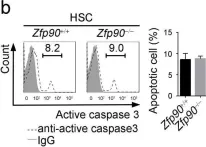Cancer stem cells are essential for initiation and therapy resistance of many cancers, including acute myeloid leukemias (AML). Here, we apply functional genomic profiling to diverse human leukemias, including high-risk MLL- and NUP98-rearranged specimens, using label tracing in vivo. Human leukemia propagation is mediated by a rare quiescent label-retaining cell (LRC) population undetectable by current immunophenotypic markers. AML quiescence is reversible, preserving genetic clonal competition and epigenetic inheritance. LRC quiescence is defined by distinct promoter-centered chromatin and gene expression dynamics controlled by an AP-1/ETS transcription factor network, where JUN is necessary and sufficient for LRC quiescence and associated with persistence and chemotherapy resistance in diverse patients. This enables prospective isolation and manipulation of immunophenotypically-varied leukemia stem cells, establishing the functions of epigenetic plasticity in leukemia development and therapy resistance. These findings offer insights into leukemia stem cell quiescence and the design of therapeutic strategies for their clinical identification and control.
© 2025. The Author(s).
Product Citations: 59
Epigenetic mechanisms controlling human leukemia stem cells and therapy resistance.
In Nature Communications on 3 April 2025 by Takao, S., Morell, V., et al.
-
Mus musculus (House mouse)
-
Cancer Research
-
Genetics
-
Stem Cells and Developmental Biology
Epi-microRNA mediated metabolic reprogramming counteracts hypoxia to preserve affinity maturation.
In Nature Communications on 3 December 2024 by Nakagawa, R., Llorian, M., et al.
To increase antibody affinity against pathogens, positively selected GC-B cells initiate cell division in the light zone (LZ) of germinal centers (GCs). Among these, higher-affinity clones migrate to the dark zone (DZ) and vigorously proliferate by utilizing energy provided by oxidative phosphorylation (OXPHOS). However, it remains unknown how positively selected GC-B cells adapt their metabolism for cell division in the glycolysis-dominant, cell cycle arrest-inducing, hypoxic LZ microenvironment. Here, we show that microRNA (miR)-155 mediates metabolic reprogramming during positive selection to protect high-affinity clones. Mechanistically, miR-155 regulates H3K36me2 levels in hypoxic conditions by directly repressing the histone lysine demethylase, Kdm2a, whose expression increases in response to hypoxia. The miR-155-Kdm2a interaction is crucial for enhancing OXPHOS through optimizing the expression of vital nuclear mitochondrial genes under hypoxia, thereby preventing excessive production of reactive oxygen species and subsequent apoptosis. Thus, miR-155-mediated epigenetic regulation promotes mitochondrial fitness in high-affinity GC-B cells, ensuring their expansion and consequently affinity maturation.
© 2024. The Author(s).
-
FC/FACS
-
Mus musculus (House mouse)
-
Biochemistry and Molecular biology
-
Cell Biology
JAK inhibition enhances checkpoint blockade immunotherapy in patients with Hodgkin lymphoma.
In Science on 21 June 2024 by Zak, J., Pratumchai, I., et al.
Unleashing antitumor T cell activity by checkpoint inhibitor immunotherapy is effective in cancer patients, but clinical responses are limited. Cytokine signaling through the Janus kinase (JAK)-signal transducer and activator of transcription (STAT) pathway correlates with checkpoint immunotherapy resistance. We report a phase I clinical trial of the JAK inhibitor ruxolitinib with anti-PD-1 antibody nivolumab in Hodgkin lymphoma patients relapsed or refractory following checkpoint inhibitor immunotherapy. The combination yielded a best overall response rate of 53% (10/19). Ruxolitinib significantly reduced neutrophil-to-lymphocyte ratios and percentages of myeloid suppressor cells but increased numbers of cytokine-producing T cells. Ruxolitinib rescued the function of exhausted T cells and enhanced the efficacy of immune checkpoint blockade in preclinical solid tumor and lymphoma models. This synergy was characterized by a switch from suppressive to immunostimulatory myeloid cells, which enhanced T cell division.
-
Cancer Research
-
Immunology and Microbiology
Severely polarized extracellular acidity around tumour cells.
In Nature Biomedical Engineering on 1 June 2024 by Feng, Q., Bennett, Z., et al.
Extracellular pH impacts many molecular, cellular and physiological processes, and hence is tightly regulated. Yet, in tumours, dysregulated cancer cell metabolism and poor vascular perfusion cause the tumour microenvironment to become acidic. Here by leveraging fluorescent pH nanoprobes with a transistor-like activation profile at a pH of 5.3, we show that, in cancer cells, hydronium ions are excreted into a small extracellular region. Such severely polarized acidity (pH <5.3) is primarily caused by the directional co-export of protons and lactate, as we show for a diverse panel of cancer cell types via the genetic knockout or inhibition of monocarboxylate transporters, and also via nanoprobe activation in multiple tumour models in mice. We also observed that such spot acidification in ex vivo stained snap-frozen human squamous cell carcinoma tissue correlated with the expression of monocarboxylate transporters and with the exclusion of cytotoxic T cells. Severely spatially polarized tumour acidity could be leveraged for cancer diagnosis and therapy.
© 2024. The Author(s), under exclusive licence to Springer Nature Limited.
-
Cancer Research
ΔNp63 regulates MDSC survival and metabolism in triple-negative breast cancer.
In IScience on 19 April 2024 by Kim, U., Debnath, R., et al.
Triple-negative breast cancer (TNBC) contributes greatly to mortality of breast cancer, demanding new targetable options. We have shown that TNBC patients have high ΔNp63 expression in tumors. However, the function of ΔNp63 in established TNBC is yet to be explored. In current studies, targeting ΔNp63 with inducible CRISPR knockout and Histone deacetylase inhibitor Quisinostat showed that ΔNp63 is important for tumor progression and metastasis in established tumors by promoting myeloid-derived suppressor cell (MDSC) survival through tumor necrosis factor alpha. Decreasing ΔNp63 levels are associated with decreased CD4+ and FOXP3+ T-cells but increased CD8+ T-cells. RNA sequencing analysis indicates that loss of ΔNp63 alters multiple MDSC properties such as lipid metabolism, chemotaxis, migration, and neutrophil degranulation besides survival. We further demonstrated that targeting ΔNp63 sensitizes chemotherapy. Overall, we showed that ΔNp63 reprograms the MDSC-mediated immunosuppressive functions in TNBC, highlighting the benefit of targeting ΔNp63 in chemotherapy-resistant TNBC.
© 2024 The Authors.
-
Biochemistry and Molecular biology
-
Cancer Research
-
Cell Biology
In Cell Death Dis on 7 June 2018 by Liu, T., Kong, W. X., et al.
Fig.2.B

-
FC/FACS
-
Mus musculus (House mouse)
Collected and cropped from Cell Death Dis by CiteAb, provided under a CC-BY license
Image 1 of 1
